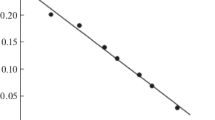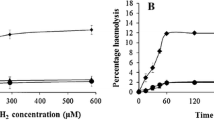Summary
Biologically active125I-cytotoxin fromPseudomonas aeruginosa binds to plasma membranes from Ehrlich ascites tumor cells in a saturable manner. The Scatchard plot indicated a single binding site with a capacity of 260 pmoles/mg of membrane protein and aK D of 2×10−8 M. Specific binding was dependent on temperature, pH and ionic strength. Thus constant levels of bound125I-cytotoxin were attained either within 30 min at 30°C or within 3 h at 4°C. Binding was 30-fold higher at 4°C vs 30°C and 2-6-fold higher at pH 5.3 vs pH 8.3. Binding was not effected by 50 mM sugar or sialic acid. 300 mM sucrose, however, instead of phosphate buffer, reduced binding by 50%. Pretreatment of plasma membranes with trypsin or papain led to a significant decrease in125I-cytotoxin binding. A pretreatment with phospholipase C or D had no effect, whereas phospholipase A2 induced a decrease by 34%. The collected data suggest that the binding site for125I-cytotoxin within the plasma membrane from Ehrlich ascites tumor cells is a membrane protein.
Correlation of125I-cytotoxin binding and membrane action of the unlabelled cytotoxin can be observed through (a) increased lowering of the cellular K+ and Na+ gradient by decrease of medium pH, (b) decreased toxicity after substitution of ions by sugar, and (c) increased breakdown of cellular cationic gradient after temperature shift from 4°C to 37°C.
Similar content being viewed by others
References
Adair WL, Kornfeld S (1974) Isolation of the receptors for wheat germ agglutinin and theRicinus communis lectins from human erythrocytes using affinity chromatography. J Biol Chem 249:4696–4704
Alberts B, Bray D, Lewis J, Raff M, Roberts K, Watson JD (1983) Molecular biology of the cell. Garland Publishing, Inc, New York and London, p 322
Chang T, Neville DM Jr (1978) Demonstration of diphtheria toxin receptors on surface membranes from both toxin-sensitive and toxin-resistant species. J Biol Chem 253:6866–6871
Fishman WH, Springer B, Brunetti R (1948) Application of an improved glucuronidase assay method to the study of human blood β-glucuronidase. J Biol Chem 173:449–456
Frimmer M, Homann J, Petzinger E, Rufeger U, Scharman W (1976) Comparative studies on isolated rat hepatocytes and AS-30D hepatoma cells with leucocidin fromPseudomonas aeruginosa. Naunyn-Schmiedeberg's Arch Pharmacol 295: 63–69
Gladstone GP, van Heyningen WE (1957) Staphylococcal leucocidins. Br J Exp Pathol 38:123–137
Glossmann H, Lutz F (1970) Molecular weights of pig liver cell membrane proteins. Hoppe-Seyler's Z Physiol Chem 351: 1583–1585
Harper AE (1962) Glucose-6-phosphatase. In: Bergmeyer HE (ed) Methoden der enzymatischen Analyse. Verlag Chemie, Weinheim, pp 788–792
Hirayama T, Kato I, Matsuda F, Noda M (1983) Crystallization and some properties of leukocidin fromPseudomonas aeruginosa. Microbiol Immunol 27:575–588
Hirayama T, Noda M, Matsuda F, Nagamori M, Kato I (1984) Binding of pseudomonal leukocidin to rabbit polymorphonuclear leukocytes. Infect Immun 46:631–634
Kaneda Y, Uchida T, Mekada E, Nakanishi M, Okada Y (1984) Entry of diphtheria toxin into cells: Possible existence of cellular factor(s) for entry of diphtheria toxin into cells was studied in somatic cell hybrids and hybrid toxins. J Cell Biol 98:466–472
Kilberg MS, Christensen HN (1979) Electron-transferring enzymes in the plasma membrane of the Ehrlich ascites tumor cell. Biochemistry 18:1525–1530
Lutz F (1979a) Purification and partial characterization of a cytotoxin fromPseudomonas aeruginosa. Naunyn-Schmiedeberg's Arch Pharmacol 307:R26
Lutz F (1979b) Purification of a cytotoxic protein fromPseudomonas aeruginosa. Toxicon 17:467–475
Lutz F, Grieshaber S, Käufer I (1981) Cytotoxin fromPseudomonas aeruginosa in mice: distribution related to pathology. Toxicon 19:763–771
Lutz F, Grieshaber S, Schmidt K (1982) Permeability changes of Ehrlich mouse ascites tumor cells induced by a cytotoxin fromPseudomonas aeruginosa. Naunyn-Schmiedeberg's Arch Pharmacol 320:78–80
Lutz F, Seeger W, Schischke B, Weiner R, Scharmann W (1983) Effects of a cytotoxic protein fromPseudomonas aeruginosa on phagocytic and pinocytic cells: in vitro and in vivo studies. Toxicon Suppl 3:257–260
Markwell MAK, Haas SM, Bieber LL, Tolbert NE (1978) A modification of the Lowry procedure to simplify protein determination in membrane and lipoprotein samples. Anal Biochem 87:206–210
Middlebrook JL, Dorland RB, Leppla SH (1978) Association of diphtheria toxin with Vero cells. J Biol Chem 253:7325–7330
Miyachi Y, Chrambach A, Mecklenburg R, Lipsett MB (1973) Preparation and properties of125H-LH-RH. Endocrinology 92:1725–1730
Munro HN, Fleck A (1966) Recent developments in the measurements of nucleic acids in biological materials. A supplementary review. Analyst 91:78–88
Obrig TG, Baltch AL, Moran TP, Mudzinski SP, Smitz RP, Lutz F (1984) Effect ofPseudomonas aeruginosa cytotoxin on thymidine incorporation by murine splenocytes. Infect Immun 45:756–760
Olsnes S, Saltvedt E, Pihl A (1974) Isolation and comparison of galactose-binding lectins fromAbrus precatorius andRicinus communis. J Biol Chem 249:803–810
Pennington RJ (1961) Biochemistry of dystrophic muscle. Mitochondrial succinate-tetrazolium reductase and adenosine triphosphatase. Biochem J 80:649–654
Proia RL, Hart DA, Holmes RK, Holmes KV, Eidels L (1979) Immunoprecipitation and partial characterization of diphtheria toxin-binding glycoproteins from surface of guinea pig cells. Proc Natl Acad Sci USA 76:685–689
Sandvig K, Olsnes S, Pihl A (1976) Kinetics of binding of the toxic lectins abrin and ricin to surface receptors of human cells. J Biol Chem 251:3977–3984
Scatchard G (1949) The attraction of proteins for small molecules and ions. Ann NY Acad Sci 51:660–672
Scharmann W (1976a) Purification and characterization of leucocidin fromPseudomonas aeruginosa. J Gen Microbiol 93:292–302
Scharmann W (1976b) Cytotoxic effects of leukocidin fromPseudomonas aeruginosa on polymorphonuclear leukocytes from cattle. Infect Immun 13:836–843
Scharmann W (1976c) Interaction of purified leukocidin fromPseudomonas aeruginosa with bovine polymorphonuclear leukocytes. Infect Immun 13:1046–1053
Weiner R, Reinacher M (1982) Lower nephron toxicity of a highly purified cytotoxin fromPseudomonas aeruginosa in rats. Exp Mol Pathol 37:249–271
Author information
Authors and Affiliations
Rights and permissions
About this article
Cite this article
Lutz, F. Interaction ofPseudomonas aeruginosa cytotoxin with plasma membranes from Ehrlich ascites tumor cells. Naunyn-Schmiedeberg's Arch. Pharmacol. 332, 103–110 (1986). https://doi.org/10.1007/BF00633206
Received:
Accepted:
Issue Date:
DOI: https://doi.org/10.1007/BF00633206




